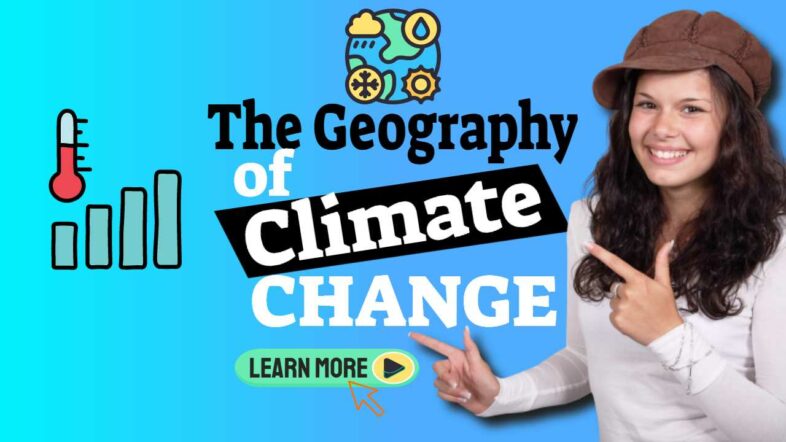In 2018, I had the opportunity to walk across the surface of an Icelandic glacier that was receding and consider the geography of climate change. I could see a patch of snow and ice off in the distance, the last remnants of another glacier that had long since melted. That ice-strewn area was all that remained of the 800-year-old Okjokull, or “Ok” glacier, which was declared dead in 2014 by Icelandic geologist Oddur Sigursson. It once covered an area of 38 square kilometres. Okjokull’s demise was commemorated with a plaque in 2019 at the former glacier’s location.
Okjokull’s Demise – The First Glacier to Go
It is the first monument dedicated to a glacier that has been lost due to human-caused global warming. It is everyone’s responsibility to care for our planet and all of its dynamic ecosystems and landscapes, including glaciers. We know that rising temperatures are associated with rising carbon dioxide levels in the atmosphere, and the amount of carbon dioxide produced by our daily activities can have an impact on the other side of the globe. However, while individual actions do matter, who emits carbon dioxide is highly unequal.
In 2019, direct emissions from corporations accounted for roughly half of total US emissions, coming from sources such as power plants and oil and gas production facilities.
As a result, they are also responsible for sharing the burden. Understanding climate change requires more than just knowing who or what emits carbon dioxide. We also investigate who is affected by emissions and the geographical consequences of a warming planet. Because climates are complicated, we don’t have all the answers, but there is a lot we can learn.
INTRODUCTION – Geography of Climate Change
Even with a complex problem like climate change, we can start with a picture. As in this 2004 photograph of Alaska’s Muir Glacier. Images and maps can show us the location of land masses, oceans, and geographical features, which is spatial information that we take for granted. The Earth is dynamic, and we must remember that both photographs and maps are snapshots of a specific time.
So, if we compared this image to previous ones of the same area, we’d be able to see how it’s changed and investigate why change is occurring here.
A 1941 photograph taken from the same location as the recent photograph shows a completely different landscape. The glacier was significantly larger. We know glaciers around the world, including Alaska, the Swiss Alps, and Mount Kilimanjaro, have shrunk dramatically after studying old and new photographs, glaciological surveys, and the geologic record.
Muir Glacier is one such example. To delve deeper into the “why,” we know that as air temperatures rise, ice and snow melt faster.
However, glaciers are also affected by the amount of precipitation that falls each year; if less snow falls, glaciers lose more ice on their bottom edge than they can replace at the top. That precipitation originates in the hydrosphere, and its regional patterns are influenced by temperature and wind patterns over vast oceans. As a result, mountain landscapes have changed as climate patterns have changed, which links back to the global energy budget, insolation, and the formation of the Earth. It’s a difficult problem.
The Difference Between “Climate Change” and “Global Warming”
“Climate change” and “global warming” are frequently used interchangeably.
Despite the fact that these phenomena are closely related, there is a distinction between them. Climate change is the long-term change in average weather patterns in a region. These changes can be natural or anthropogenic, which means caused by humans. And by “long,” I mean that each climate period can last several decades or longer. For example, from 1300 to 1850 CE, there was a Little Ice Age.
Mountain glaciers have expanded globally, and mean annual temperatures in the Northern Hemisphere have dropped by 0.6 degrees Celsius. That’s a climate pattern that lasted 550 years before shifting to a different one. Global warming, on the other hand, is defined as an increase in our planet’s average surface temperature. Since the Industrial Revolution in the 17th and 18th centuries, there has been a well-documented rise in average temperatures around the world during our current period of global warming. And this is relevant to the geography of Climate Change.
When scientists or leaders speak of “global warming,” they almost always refer to the recent warming caused by human activities that increase greenhouse gas emissions such as carbon dioxide, methane, and nitrous oxide.
They trap solar energy, retaining more heat in the atmosphere. That extra energy is influencing not only the average temperature but also climate processes in the atmosphere and oceans. These include more severe storms, heatwaves, and droughts, as well as changing regional temperature and precipitation patterns that cause vegetation zones to shift and glaciers to melt, resulting in sea-level rise and shifting coastlines. Climates change essentially as the planet warms.

The Paleoclimatology Research
Thanks to paleoclimatologists, who study past climates using proxy data, or data that provides clues about the past, we know the Earth has had many different climates. Comparing multiple proxies provides a more complete picture of what occurred and assists us in anticipating the changes for which we must prepare. For example, they use tree rings to show dry and wet years, fossilised bugs to learn about moisture and temperature levels in past ecosystems, and deep-sea sedimentary records to learn about the ocean’s past. The deep-sea sedimentary record, for example, shows that the Earth overall experienced one of two extreme climates. The geography of climate change was shown as glaciers advanced and receded across the globe at least 28 times over the last 2.6 million years.
We can see that glaciation occurs and sea levels fall when glaciers advance and the climate is colder.
And, as the climate warms, glaciers recede and sea levels rise, ushering in an interglacial period. Which is where we are right now. Ice core data is one of the most useful types of proxy data for atmospheric conditions and how climates changed year to year. We can extract the chemical composition of past atmospheres from ice.
Paleoclimatologists have extracted long tubes of ice from ice sheets and alpine glaciers all over the world using special drills, and estimated climates dating back at least 400,000 years.
On top is fresh snow from this year, last year, and the year before that. Underneath is the snow that fell during Marco Polo’s Silk Road journey, and beneath that, when the Buddha attained enlightenment. The geography of climate change shows that the deepest layers were formed long before recorded history.
Very Old Snow
Snow that fell before the beginning of the last ice age, 115,000 years ago or more, can be found at the very bottom of ice sheets in places like Greenland and Antarctica. Snow on ice sheets is compacted into huge solid masses, much like snow on a sidewalk can be compressed by boots into sheets of slippery ice. And evidence of past atmospheric conditions is buried in each layer of ice: tiny air bubbles that act as time capsules. Once an ice core has been transported from the field to the lab, scientists use isotope dating to determine whether the carbon dioxide in those frozen bubbles was released from burning materials such as wood or coal in the lithosphere, if it was airborne during a nuclear explosion, or if it was part of the natural carbon cycling. Paleoclimatologists have collected and analysed polar ice core samples from Greenland and Antarctica, tropical glaciers in the Andes and Kenya, and mid-latitude glaciers in the Alps and Himalayas. Such is the geography of climate change.
When all of these data points are gathered, scientists can compare them to see atmospheric trends, which in turn show climate change over thousands of years. According to research, it only takes a few decades to shift from colder to warmer climate patterns. That may not appear to be fast, but when you’re on a 4.5 billion-year-old planet like Earth, it’s nothing. Thought Bubble, thank you.
What Exactly Is Climate Change?
We know the Earth’s climate has changed significantly many times by analysing proxy data such as bubbles in ice cores. Let us delve deeper as geographers into the reasons for these drastic changes in the geography of climate change. Paleoclimatologists hypothesise that climates change due to any combination of several driving forces based on proxy data. For starters, past climates could have changed due to orbital factors such as changes in the shape of the Earth’s orbit, tilt on its axis, and the time of year when the sun is closest to the Earth. Calculations by mathematician Milutin Milankovitch, for example, show that many glacial cycles occur every million years.
Volcanic Activity and the Albedo Effect
Second, volcanic activity can cause massive amounts of volcanic dust to be released into the stratosphere. Strong winds blow dust all over the world, darkening the skies and reducing the amount of insolation that can reach the surface, lowering temperatures. This is related to the albedo effect, or the amount of sunlight reflected back into space by a surface. The albedo of the Earth is affected by volcanic dust and even surface colour. White surfaces, such as ice, reflect the Sun’s energy and thus provide cooling.
Asteroid Impact Winters
When there is less ice, the opposite occurs: darker surfaces absorb sunlight and warm the Earth’s surface.
Similarly, when a large object, such as an asteroid, strikes, it can cause an “impact winter.” A large impact, like volcanic activity, throws dust and debris into the air, blocking out sunlight and lowering temperatures. A similar impact could have wiped out the dinosaurs 65 million years ago. Another cause of climate change is the repositioning of continents and oceans.
 When the Isthmus of Panama formed, it severed the connection between the Atlantic and Pacific Oceans, re-directing ocean circulation and resulting in the formation of the Gulf Stream. This altered the movement of moisture and ocean currents around the globe, which, as we know, influences climate patterns. Finally, climates change as the levels of greenhouse gases in the atmosphere fluctuate. According to ice core data, carbon dioxide levels in the atmosphere decreased during ice ages and increased during interglacial periods. What is happening now, however, is unlike anything that has happened before.
When the Isthmus of Panama formed, it severed the connection between the Atlantic and Pacific Oceans, re-directing ocean circulation and resulting in the formation of the Gulf Stream. This altered the movement of moisture and ocean currents around the globe, which, as we know, influences climate patterns. Finally, climates change as the levels of greenhouse gases in the atmosphere fluctuate. According to ice core data, carbon dioxide levels in the atmosphere decreased during ice ages and increased during interglacial periods. What is happening now, however, is unlike anything that has happened before.
We are currently in an interglacial period, and glaciers are melting faster than ever before in geologic history.
Sea Level has Risen Already in Last 100 Years
During the last 100 years, average annual global temperatures have risen by 0.3 to 0.6 degrees Celsius, and the sea level has risen by 10 to 25 cm. And, in 2016, global atmospheric carbon dioxide levels surpassed 400 parts per million for the first time in a million years.
More CO2 increases the amount of heat trapped in the lower atmosphere, thereby enhancing the natural greenhouse effect that allows life to exist. As a result, our climates are changing. Geographers would consider this upward trend in global temperatures to be natural climate change if it were caused solely by natural processes. But, as I previously stated, what is happening now is unlike anything we’ve ever witnessed on Earth. To study the climate, scientists have used a variety of evidence, including tree ring and ice core data, glacial retreat and sea-level rise, isotope dating, changes in the atmosphere, and changes in weather phenomena.
And they’ve concluded that human activities, such as the use of fossil fuels, industrialization, modern agriculture, and deforestation, are responsible for the majority of the Earth’s warming since the mid-twentieth century.
Anthropogenic global warming
Anthropogenic global warming is occurring. However, not all areas will be equally affected by global warming and modern climate change. While materially rich countries are the main producers of greenhouse gas emissions, materially poorer countries will bear the brunt of the consequences, such as climate refugees fleeing their homes in search of safer places. Thousands of low-lying islands and coastal cities will be threatened by rising sea levels by the end of the twenty-first century when sea levels are expected to have risen by 26 to 77 centimetres.
That’s significant given that more than half of the world’s population lives within 100 kilometres of a coastline. Kiribati, for example, is located halfway between Australia and Hawaii and has 33 atolls that are less than 2 metres above sea level and only a few hundred metres wide on average. Kiribati’s government is planning a two-phase “migration with dignity” and has purchased thousands of acres of land in Fiji as a potential resettlement site for its 102,000 residents. However, “dignified migration” is not an option for all countries and communities.
For some areas, adaptation, such as building sea walls or raising streets and homes, is the only option.
And for some, that will entail moving to higher elevations following the flooding without government assistance. Flooding caused by sea-level rise is just one of many changes that we can expect.
Other areas, for example, will have drier conditions, with the possibility of droughts, heatwaves, and wildfires. The current ways in which the Earth’s climate is changing as a result of global warming will affect all of us as individuals, so it is our collective responsibility to pay attention and act to reduce the effects of the changing geography of climate change. The thing about human-caused climate change is that knowing we are the primary cause means we have the ability to try to stop it!
A Small Window of Opportunity
We still have a small window of opportunity to collaborate and aggressively reduce our emissions in order to save communities all over the world from disaster.
Individual choices can help, but we must also hold corporations and governments accountable for policies and large-scale emissions that affect our atmosphere and climate. This will ensure that future generations inheriting our planet have a safer, healthier, and more biodiverse future. I understand that the issue of global warming may appear overwhelming; you are not alone. But, thanks to decades of scientific research, we know what the problem is and what the solutions are.
It is now only a matter of successfully integrating them into society.
The author wishes to recognise these peoples’ traditional and ongoing relationship with that land, as well as all of its physical and human geographical elements.
We encourage you to learn about the history of the place you call home by visiting native-land.ca and connecting with your local Indigenous and Aboriginal nations via the websites and resources they provide. Thank you for watching this episode of Crash Course Geography, which was shot at the Team Sandoval Pierce Studio with the help of all these wonderful people. If you want to help keep Crash Course free for everyone forever, you can join our Patreon community.
From Humble Beginnings to Industry Leaders: The Story of Landia UK’s Growth with Liz Robinson
Discover the remarkable 30-year journey of Landia UK, a leader in pump manufacturing. Join Liz Robinson as she reflects on her pivotal role from the company’s humble beginnings to its status as an industry innovator in the UK and Ireland. Learn how Landia UK’s commitment to quality and customer service has driven its growth and […]
15 Ways to Prevent Climate Change
Here we describe 15 great Ways to Prevent Climate Change. There are a huge number of ways you can help prevent climate change, from making small changes to your daily routine to voting in elections that promote environmental change. Are you in a rush? Then just read this! Below are ten quick suggested actions that […]
Overfishing – Causes of Overfishing and Overfishing Solutions
The term overfishing is often assumed to refer to the overfishing of fish but in fact, it refers to all aquatic species including shellfish, crabs, lobsters and many others. In a recent study, the University of British Columbia found that China provides the most harmful subsidies to the industry. In fact, in 2011, they provided […]
Benefits of Depackaging Equipment: Sustainable Organic Waste Processing to Reduce Waste & Raise Profitability
We discuss the benefits of depackaging equipment. The news is that the latest “low destruction” energy-efficient and microplastics avoiding depackaging equipment has now improved to provide reliable “bankable” sustainable Organic Waste Processing which really can reduce waste for all operators of organic waste (especially food waste) reprocessing facilities while simultaneous raising the profitability of organic […]







